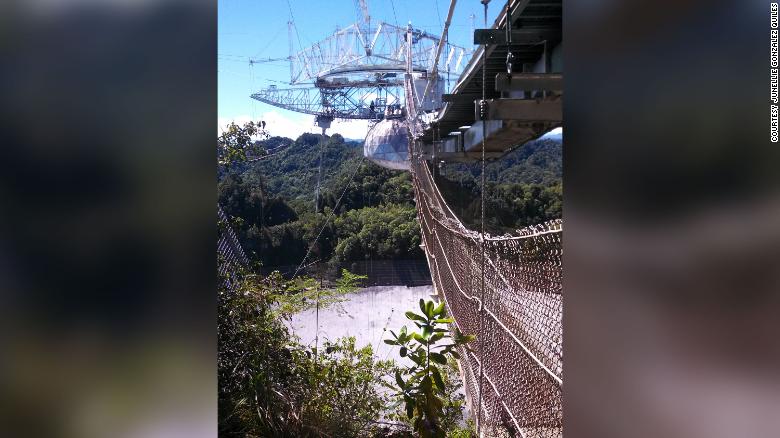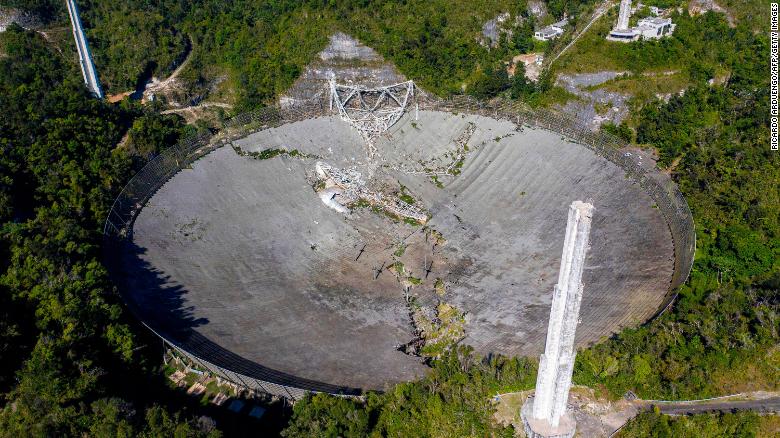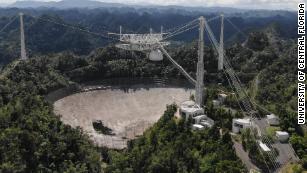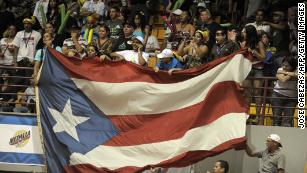The economic loss of Puerto Rico's Arecibo Observatory is already being felt. It's also very personal
(CNN)Junellie González Quiles peered into her first telescope when she was 10 years old and what she saw were stars, planets, and a doorway into a world of science made possible by Puerto Rico's iconic Arecibo Observatory.
Observatory astronomers once brought some telescopes to a summer camp she attended as a girl growing up in San Juan, part of one of Arecibo's various educational programs -- the future of which are now unclear.
The observatory has been an integral part of the island's education, science and business sectors that islanders and experts contend must be rebuilt after the US National Science Foundation decided in late November to decommission and disassemble Arecibo through a controlled demolition due to irreparable damage. That damage, sustained this summer, resulted in its 900-ton equipment platform collapsing last week.

Junellie González Quiles is one of thousands of Puerto Rican students to visit the Arecibo Observatory since it was commissioned into service in 1963.
Using the hashtag #WhatAreciboMeansToMe, González Quiles, now a 24-year-old doctoral student at Johns Hopkins University studying exoplanets in the Department of Earth and Planetary Sciences, shared how the observatory affected her life while growing up in the island's capital.
"The Arecibo Observatory being in Puerto Rico has inspired us Puerto Ricans to pursue scientific knowledge and it taught us that not even the sky is our limit," González Quiles told CNN over email. "We can go beyond. The impact that it has had on the education system in Puerto Rico and the training it has provided for many scientists has been very significant. The Arecibo Observatory is the science icon for Puerto Rico and we take pride in it because of its impact on Puerto Rico and the world."
The economic impact of losing the observatory
The Foundation for Puerto Rico has been intimately involved with Arecibo and studying the economic influence the observatory has had on the community.
The foundation was founded as a nonprofit in 2011 and works to create opportunities that drive social and economic development in Puerto Rico, with a focus on the visitor economy.
The observatory attracted roughly 50,000 students and 50,000 other visitors on average each year before Hurricane Maria, said Carlos Ayala, a program manager for the Foundation for Puerto Rico's Bottom Up Destination Recovery Initiative.
Ayala spent six months living in Arecibo in 2019 to study the visitor economy of under-served communities on the island. What he learned was how each non-student visitor to the Arecibo region spent approximately $171 daily and lodged in the area for five to seven days, he said.
"The region will suffer because a 50,000 drop (in visitors) is notable," Ayala said
Mestizo Café and Supermarket Samcoop 4 Calles are two of the many local businesses that have relied on a steady stream of observatory tourists. Its closing has already hurt business, cafe owner David Gonzales told CNN on Friday over the phone.
"The count of clients has gone down," Gonzales said. "The observatory closing is having an impact because people would come to visit the area and spend time in the town of Arecibo. Arecibo does not have too many places to visit; the observatory was the most important attraction."
This was a similar situation at the supermarket. Manager Neysha Berenice Domenech said many tourists would stop at the store to pick up drinks and snacks on their way to the observatory.
"Now we are going to have less people, which is very sad after having the observatory for many years and it being one of the biggest ones of the world," Domenech told CNN over the phone. "It was very important for the Puerto Rican people."
Tourism is a crucial sector for the island which in 2018 reported a 43% poverty rate, according to the US Census. In 2017, tourism made up approximately 7% of the island's GDP, according to an analysis by the Foundation for Puerto Rico.
The observatory itself employs roughly 130 people who largely live in and around Arecibo, said Ray Lugo, the observatory's principal investigator and the director of the University of Central Florida's Space Institute. There will be no changes to their roles for the foreseeable future, Lugo said.
A scientific marvel that educated the masses
The observatory, which was featured in the James Bond film "GoldenEye" and the sci-fi movie "Contact," has been helmed by the US National Science Foundation (NSF) since 1970.
Lugo was the author of the grant proposal to the NSF which awarded the University of Central Florida operational control of the Arecibo Observatory in 2018, he said. Since then, the university has been responsible for maintaining the facility, conducting and coordinating scientific research, and running education programs, he said in a phone interview.

A look at the Arecibo Observatory's platform. This is what collapsed last week.
The scientific research conducted at the observatory falls into three main categories: radio astronomy (the collection of radio signals from things like stars and planets), planetary radar group (which works closely with NASA's Near-Earth Object (NEO) Observations Program), and atmospheric science (involves experiments where the upper atmosphere is heated up and probed), Lugo said.
So far this year, research at the observatory had characterized the spin, rotation, and shape of 67 asteroids before an auxiliary cable came loose from a socket on one of the site's towers in August, Lugo said.
This research adds to a litany of scientific accomplishments at the observatory, including its assistance in discovering the first binary pulsar in 1974 (which led to the 1993 Nobel Prize in physics). The observatory has also supported NASA's Viking mission, which produced the first radar maps of Venus' surface and spotted the first exoplanet in 1992.

This aerial view shows the damage at the Arecibo Observatory after one of the main cables holding the receiver broke in Arecibo, Puerto Rico, on Dec. 1, 2020.
To date, the research conducted at the observatory has helped roughly 400 students around the world earn doctoral degrees, Lugo said.
Despite the heavy damage to parts of the telescope, much of the observatory's research will continue using other hardware on site and through analyzing huge stockpiles of data already collected, Lugo said.
The observatory has partnered with the Ana G. Méndez University System to educate students of all ages. One of the crown jewels of its educational programs is its Arecibo Observatory Space Academy where students are brought on-site to conduct research alongside field professionals. González Quiles participated in the program in 2013.
"The experience at the Arecibo Observatory was incredible, it was my first time doing scientific research," González Quiles said. "During my time at the academy, we worked on projects that aimed to fulfill one goal, which was to design a space settlement for the NASA Ames Space Settlement Design Contest. I worked on the aerospace engineering for the design."
Ayala was also one of the scores of Puerto Rican students to visit the observatory when he was a young student. He lamented the thought of children not being able to visit it.
"Losing this important asset, it's really a tragedy for the public school kids," Ayala said. "Most of the kids in Puerto Rico can't go to a space camp in the United States and can't get access to that scientific knowledge."
Charting a path to the Arecibo Observatory's future
Restoring the Arecibo Observatory to its former glory is not enough for Annie Mayol, the president and chief operating officer of the Foundation for Puerto Rico.
Mayol believes that improving the roads leading to a rebuilt observatory and adding things like a small hotel on site will draw more visitors.
"We are about asset rehabilitation and we're about sustainable tourism," Mayol said. "It's about making sure that we support our science, our community and our students who actually grow and use this as an inspiration."
Mayol is hopeful that the incoming Biden-Harris administration will "be looking at Puerto Rico with a different eye" and allocate federal funding to rebuild the site.
A petition titled "Rebuild the Arecibo Observatory" was launched on Dec. 2 and has since collected more than 39,000 digital signatures as of Sunday morning. It calls on "Congress to allocate funding to build a new Arecibo radio telescope with greater capabilities than the previous telescope -- to maintain American leadership in planetary defense, astronomy, and ionospheric studies; and to inspire a new generation of scientists."
Over the past few months, Lugo said he has met with 25 members of Congress and the governor of Puerto Rico to advocate for rebuilding the observatory.
Lugo estimates that it would cost $400 million to rebuild the Arecibo Observatory.
"We are working very hard on Arecibo model 2," he said. "There is already a movement and it's going to build momentum over the next couple of weeks."
CNN's Melissa Macaya and Ashley Strickland contributed to this report.


No comments:
Post a Comment